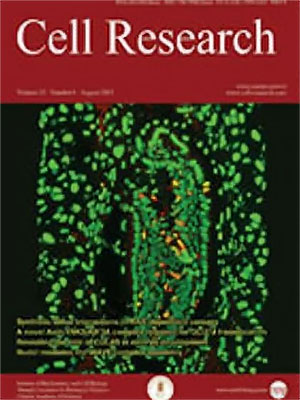
Volume 13, No 4, Aug 2003
ISSN: 1001-0602
EISSN: 1748-7838 2018
impact factor 17.848*
(Clarivate Analytics, 2019)
Volume 13 Issue 4, August 2003: 251-263
ORIGINAL ARTICLES
Embryonic stem cells generated by nuclear transfer of human somatic nuclei into rabbit oocytes
Ying CHEN1, 2, Zhi Xu HE3, Ailian LIU1, 2, Kai WANG1, 2, Wen Wei MAO1, 2, Jian Xin CHU1, 2, Yong LU1, 2, Zheng Fu FANG1,2, Ying Tang SHI1, 2, Qing Zhang YANG1, 2, Da Yuan CHEN4, Min Kang WANG4, Jin Song LI4, Shao Liang HUANG3, Xiang Yin KONG5, Yao Zhou SHI5, Zhi Qiang WANG5, Jia Hui XIA6, Zhi Gao LONG6, Zhi Gang XUE6, Wen Xiang DING7, Hui Zhen SHENG1,2, *
1Center for Developmental Biology, Shanghai Second
Medical University, Shanghai 200092, China
2Laboratory of Stem Cell Biology, Institute of Biochemistry and
Cell Biology, Shanghai Institutes for Biological Sciences, Chinese Academy
of Sciences, 1665 Kong Jiang Road, Shanghai 200092, China
3Center for Stem Cell Research, the Second Affiliated Hospital,
Sun Yat-Sen University, Guangzhou 510120, China
4State Key Laboratory of Reproductive Biology, Institute of Zoology,
Chinese Academy of Sciences, 19 Zhong-guan Cun Road, Haidian District, Beijing
100080, China
5Health Science Center, Shanghai Institutes of Biological Sciences,
Chinese Academy of Sciences and Shanghai Second Medical University, Shanghai
200025, China
6National Laboratory of Medical Genetics, Central South University,
88 Xiangya Road, Changsha 410078, China
7Xinhua Hospital, Shanghai Second Medical University, 1665 Kong
Jiang Road, Shanghai 200092, China
Correspondence: Hui Zhen SHENG(hzsheng@sh163a.sta.net.cn)
To solve the problem of immune incompatibility, nuclear transplantation has been envisaged as a means to produce cells or tissues for human autologous transplantation. Here we have derived embryonic stem cells by the transfer of human somatic nuclei into rabbit oocytes. The number of blastocysts that developed from the fused nuclear transfer was comparable among nuclear donors at ages of 5, 42, 52 and 60 years, and nuclear transfer (NT) embryonic stem cells (ntES cells) were subsequently derived from each of the four age groups. These results suggest that human somatic nuclei can form ntES cells independent of the age of the donor. The derived ntES cells are human based on karyotype, isogenicity, in situ hybridization, PCR and immunocytochemistry with probes that distinguish between the various species. The ntES cells maintain the capability of sustained growth in an undifferentiated state, and form embryoid bodies, which, on further induction, give rise to cell types such as neuron and muscle, as well as mixed cell populations that express markers representative of all three germ layers. Thus, ntES cells derived from human somatic cells by NT to rabbit eggs retain phenotypes similar to those of conventional human ES cells, including the ability to undergo multilineage cellular differentiation.
FULL TEXT | PDF
Browse 2553


